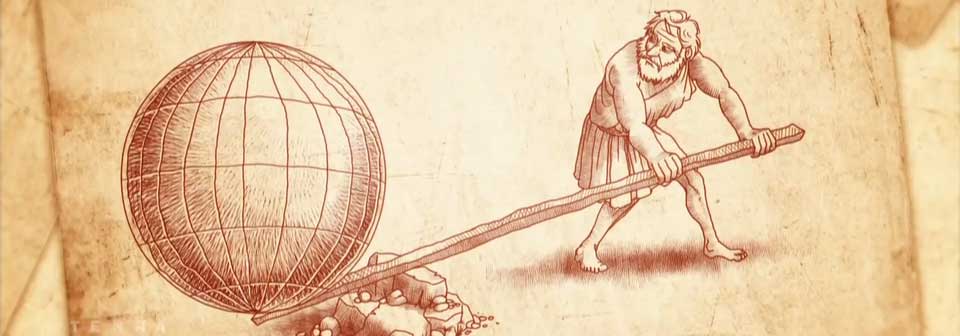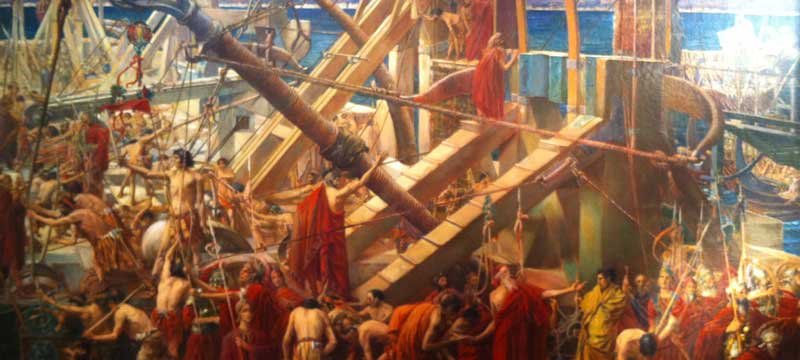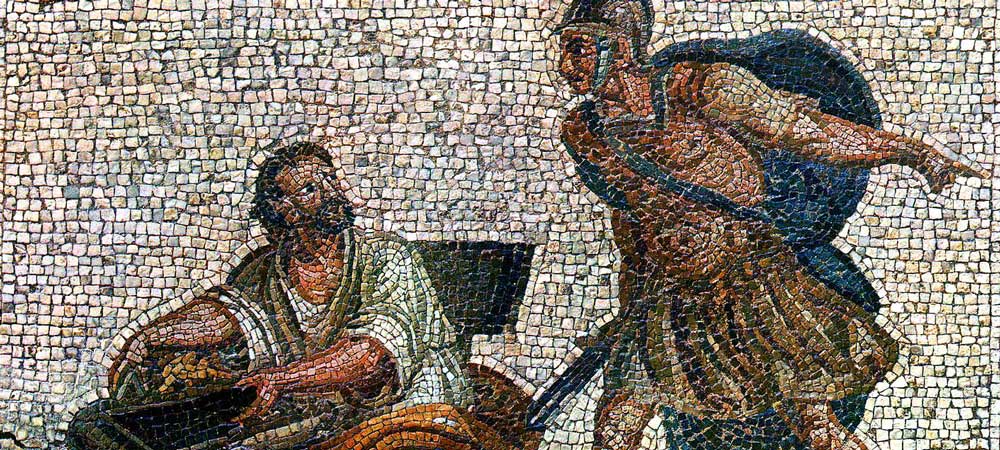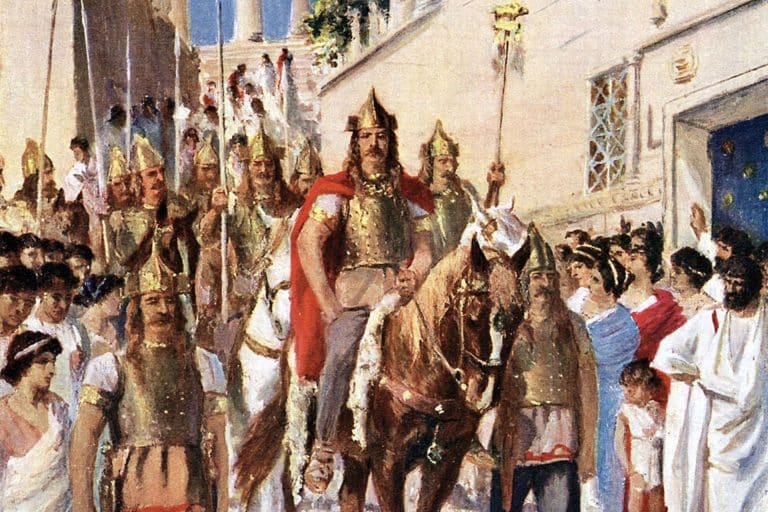15 Archimedes Discoveries That Changed the World
A Mind Ahead of His Time
Archimedes of Syracuse was born in the 3rd century BCE and is considered one of the greatest minds of the ancient world. He was a mathematician, inventor, astronomer, and engineer, and revolutionized the way we understand physics and helped develop ideas that wouldn’t fully come to fruition for thousands of years. His discoveries range from principles of buoyancy to weapons that helped save a city, but went far beyond just theoretical science to change the world around him.
In an era when most scientific and mathematical ideas were the province of mythology or simple deduction, Archimedes applied logic and experimentation to the laws of nature, forever changing the way we approach science and mathematics. His contributions are still with us in textbooks, engineering, and even the Marine Corps Hymn. These 15 discoveries help us see how Archimedes changed science, war, and mathematics forever.
1. The Principle of Buoyancy
The most celebrated scientific revelation of all time occurred to Archimedes while he was taking a bath one day. The water overflowed from his bathtub when he stepped into it, and the idea came to him that a body immersed in a fluid is acted upon by an upward force that is equal in magnitude to the weight of the fluid displaced by the body. Archimedes is reported to have jumped out of his bath and run through the streets naked, yelling “Eureka!”, and was able to discover a method for determining whether the crown was pure gold or not without damaging it, using this principle.
Archimedes’ Principle can be stated as follows: Any object, whether wholly or partially immersed in a fluid, is buoyed up by a force equal to the weight of the fluid displaced by the object. This principle explains why ships made of steel float, why submarines dive and surface, and why some objects sink and others float. The ancient scientist’s law continues to serve engineers, physicists, and naval architects. The floating of an object is only part of the story, for the control of buoyancy is the key to such modern devices as oil tankers and hot air balloons.

2. The Law of the Lever
In his work On the Equilibrium of Planes, Archimedes stated the law of the lever. He proved that two weights will balance each other when their distances from the fulcrum are inversely proportional to their masses; in other words, that a small force applied at a suitable distance from a pivot can balance a much greater force applied at a smaller distance from the same pivot. Archimedes was famously reported to have written that, “Given a place to stand on, I could move the Earth.”
The law of the lever has been one of the most useful discoveries in the history of mechanics. From levers and balance scales to seesaws, crowbars, and complex machinery, to engineering design, the principle of the lever has enabled much of technological history. Archimedes’ concise expression of this simple yet powerful fact not only helped ancient manual labor become more efficient but also laid the groundwork for classical mechanics itself. His discovery is a paradigm of physics education to this day.
3. The Archimedean Screw
Archimedes created the Archimedean screw to lift water from low-lying areas to higher ground. He may have come across this device earlier in his life while in Egypt, as the screw may have been used along the Nile River to lift water from it. The screw consists of a helical blade inside a hollow tube, which is set at an angle to a water source. Rotating the screw lifts water in pockets of the helix to higher ground. Archimedes described the screw in his writing and is one of the few devices still in use since its creation.
The screw has been used for irrigation when other means have failed. This device remains functional today, as more modern versions are utilized in wastewater treatment, hydroelectric power generation, and agriculture. Archimedes’s success with the screw demonstrates his ability to use his mathematical knowledge to improve upon or develop new machines.

depicting Archimedes Screw – Marczoutendijk, CC BY-SA 4.0, via Wikimedia Commons
4. Calculating Pi (π)
One of Archimedes’ early and best-known contributions was his use of the limit process in one of the first accurate calculations of the value of π, the ratio of the circumference of a circle to its diameter. Archimedes determined this by inscribing and circumscribing a circle with regular polygons whose sides increase in number.
He noted that the perimeter of a polygon approaching that of a circle from within is less than that of a circle and that the perimeter of a polygon approaching a circle from without is greater than the circle’s. He was thus able to determine that the value of π was between 3 1/7 (approximately 3.1429) and 3 10/71 (approximately 3.1408) by applying this method to a polygon with 96 sides.
The methods used by Archimedes to bound the value of π not only show the understanding he had of geometry, but also his understanding of logic, as his proof is, in effect, a proof by limits. He was the first to achieve a correct understanding of the problem, and his results were not to be surpassed for over a millennium.
5. The Method of Exhaustion
Integral calculus is not known to have been discovered until many centuries after the time of Archimedes. However, a process developed by Archimedes, known as the method of exhaustion, bears a striking resemblance to the process used in integral calculus. This method was used to find the area or volume of shapes with irregular curves. Archimedes would inscribe a polygon within the figure, with the number of sides increasing with each iteration. By using an ever-increasing number of sides for each polygon, the sum of the areas of the inscribed polygons would approach the total area of the figure. Archimedes could thus calculate values to high degrees of accuracy, despite this method being purely geometrical in nature.
In this way, Archimedes could calculate the area of parabolic segments, as well as the volumes of spheres and cylinders. His development of the method of exhaustion can be considered an anticipation of integral calculus, which was formalized by Newton and Leibniz some 1,800 years later.
6. Volume and Surface Area of a Sphere
Archimedes discovered these formulas for the sphere in his treatise On the Sphere and Cylinder. In this work, Archimedes proved that the volume of the sphere is two-thirds the volume of the cylinder in which it is inscribed, where the height of the cylinder is the same as its diameter. He also showed that the surface area of a sphere is four times the area of its greatest circle. Archimedes considered this result to be one of his most outstanding mathematical achievements.
The Roman writer Cicero, in a visit to Syracuse some decades after the event, learned that Archimedes had requested that a sphere and a cylinder be carved on his tombstone to celebrate this accomplishment. These results have long been considered basic in geometry, and are still among the first taught as proven truths in school mathematics.
7. Floating Bodies and Hydrostatics
Archimedes wrote On Floating Bodies, which contains his studies on how objects float in water. He determined that shape, volume, and density would decide if a body would float in equilibrium. Archimedes proved, by deriving each step mathematically, that any floating body, whether wholly or partially immersed in a fluid, is buoyed up by a force equal to the weight of the fluid displaced by the body. In “On Floating Bodies,” he also expanded on other aspects of floating bodies beyond the concept of buoyancy and displacement. He determined the stability of a floating body and the role of the center of gravity in the buoyancy and balance of bodies in water.
Hydrostatics is a branch of fluid statics based on Archimedes’ work on floating bodies. He is credited with laying the groundwork for hydrostatics and its applications in today’s world, including fields such as shipbuilding, submarines, and oil rigs.

8. Heat Ray or Solar Death Ray
Several ancient sources, including Lucian, as well as later accounts by historians such as Anthemius of Tralles, report that Archimedes devised a weapon capable of setting enemy ships on fire. He is said to have told his men to use multiple polished bronze shields or mirrors to concentrate the rays of the sun and set the enemy ships alight. In particular, when the mirrors were positioned at the proper distance and angle, the reflected beams of light allegedly heated the wooden ships of the Roman fleet from a distance, causing great confusion and terror among them.
Mirrors used to focus the sun’s rays were known to the ancients and could have been used in this way, although only under the right conditions. This was even demonstrated in the 21st century by a team at the Massachusetts Institute of Technology. However, in practice, it would only work on a sunny day with no wind when the Sun’s position was correct for such an attack, and even then, only under optimal conditions. In any case, the story is an interesting example of Archimedes’ legendary creativity and his ability and willingness to use his inventions for military purposes.
9. Catapults and Defensive Machines
Archimedes’ contributions to the defense of Syracuse are well-documented by ancient historians. During the Roman siege of the city in 214 BCE, he is credited with inventing various war machines. According to Polybius and Livy, these included catapults and ballistae capable of hurling large stones and projectiles. These machines were reportedly designed to target approaching enemies at different ranges, effectively preventing Roman troops from reaching the city walls. Some sources also suggest the use of cranes and grappling hooks, possibly mounted on the walls, to lift enemy ships out of the water and capsize them.
The effectiveness of these defensive technologies reportedly demoralized the Roman attackers and extended the siege. Archimedes’ application of his mathematical and mechanical knowledge to military technology demonstrates his practical ingenuity and adaptability. Although Syracuse eventually fell, the ingenuity of its defenses left a lasting impression, and Archimedes’ machines became legendary examples of ancient military innovation.

10. The Claw of Archimedes
One of the most terrifying and fanciful weapons of antiquity was the Claw of Archimedes, also known as the “Iron Hand.” The Claw was created for the defense of the coastal city of Syracuse, besieged by the Romans. It was essentially a giant crane equipped with a grappling hook or a metal claw. Legend (Polybius and Plutarch) has it that the Claw could extend over the city’s walls, snatch hold of a Roman ship, and lift it out of the water, before rocking it violently or capsizing it, hurling the soldiers into the sea.
No physical proof of the Claw of Archimedes has been found; however, from historical records and engineering research, several people have attempted to design the Claw, and these attempts suggest that it is quite possible to build such a machine according to the scientific principles known to Archimedes. The various replicas of the Claw designed since antiquity also bear testimony to Archimedes’ genius in applying his mathematical and scientific knowledge to real-world engineering problems.
11. Archimedes’ Planetarium
Another of Archimedes’ legendary feats, even more incredible and wondrous than the great siege weapons and defenses, was the construction of an actual mechanical model of the cosmos, a sort of planetarium. This machine, by all accounts, imitated with great precision the motions of the heavenly bodies, including the sun, the moon, the planets, and the fixed stars, as they could be seen from Earth.
The Roman statesman and orator Cicero (106–43 BCE), who had the good fortune to see it in the collection of the Roman general Marcus Marcellus (which he had carried off from Syracuse when it fell to the Romans), remarked that it showed the positions and motions of the celestial bodies with perfect accuracy, and was able to predict eclipses and planetary conjunctions hundreds of years before the construction of the modern orrery.
The planetarium of Archimedes marks the transition from scientific observation to mechanical artistry, transforming abstract movements of the cosmos into visible and understandable movements of the mechanical model. The original device, of course, is long since lost.
12. The Spiral of Archimedes
On Spirals describes Archimedes’ construction of a mathematical curve now known as the Archimedean spiral. Unlike the logarithmic spiral, this curve has the property that any two adjacent turns of the spiral are separated by the same distance at any point. Archimedes thoroughly investigated this spiral by describing its properties in polar coordinates, and also applied the Archimedean spiral to the problems of squaring the circle and trisecting an angle.
The Archimedean spiral has also influenced contemporary engineering technology. A scroll compressor, widely used in HVAC, automotive, and other applications, is a component featuring a spiral scroll. Spiral antennas are a type of frequency-independent antenna in the shape of a spiral. Vinyl phonograph records are flat disks with an Archimedean spiral that store audio signals. Archimedes’ study of spirals exemplified his remarkable ability to bridge the gap between pure mathematics and practical applications. His fascination with spirals is one way he helped make geometry an area where the abstract and the technological could be intimately connected.
13. Center of Gravity Concepts
In On the Equilibrium of Planes, Archimedes formulated the law of the lever. He also investigated the concept of the center of gravity of a body long before classical mechanics was created. He understood that the distribution of mass within an object can determine its balance. He even developed a way to find the center of gravity of regular geometric figures, and Archimedes was the first to define the center of gravity as the point at which a body can be perfectly balanced.
Archimedes’ results on the center of gravity were related to the area of statics, in which mathematical principles were used to explain why particular structures maintain their stability. Archimedes not only applied mathematics to the principles of physical statics, but he also offered geometric explanations for specific constructions for which only a particular shape is stable. In many ways, he was the first person to view the world in terms of abstract, mathematical forces.
Galileo and Newton restated the ideas of statics, demonstrating how much of classical physics is rooted in the work of Archimedes. In this treatise, Archimedes’ most famous statement is the law of the lever. In fact, it is this work, more than any other, that demonstrates how he combined pure geometry and mathematical understanding with a sense of the practical world around him. In addition to explaining some of the technology of antiquity, this also formed a necessary foundation for later architecture, engineering, and even spacecraft design.

14. The Sand Reckoner
The Sand Reckoner is a written work by Archimedes in which he addresses the problem of calculating the number of grains of sand whose number exceeds any finite number. This problem was an intellectual exercise proposed to Archimedes by his friend, and it was of such a large magnitude that even the Greek number system, which was cumbersome for large numbers, would be inadequate for handling its numerical value.
The title of the work is a reference to a famous speech in which the Greek historian Herodotus (484–425 BCE) had mocked the astronomical theories of Anaxagoras for postulating the existence of more worlds than grains of sand on the shores of the sea. To solve the problem, Archimedes conceived a system of naming large numbers, based on powers of 10, and, ingeniously, using these large numbers and the properties of geometry, he was able to show that there is room for all the grains of sand in the known universe (approx. 10^{63} grains of sand).
15. Geometric Proofs and Conic Sections
Archimedes also investigated conic sections (curves generated by intersecting a cone with a plane), which include the parabola, the ellipse, and the hyperbola. In his work Quadrature of the Parabola, he demonstrated that the area of a segment of a parabola is four-thirds the area of a specific inscribed triangle, and he proved this using a series of geometric arguments that involved infinite series and limiting processes. These mathematical techniques were not rigorously formalized until the development of calculus more than 1,800 years later.
Archimedes’s ability to use geometric proofs to solve complex mathematical problems demonstrated not only a profound understanding of mathematics but also a considerable amount of originality. His methods for dissecting curves and solids provided the groundwork for later mathematicians, such as Cavalieri and Newton. His work with conic sections provided a practical example of how rigorous geometry could be used to study complex shapes. It also foreshadowed later work in fields such as optics, astronomy, and engineering.

Enduring Genius of Archimedes
Archimedes’ impact on science, math, and engineering has not been matched in the ancient world. His achievements span a range from the general principle of buoyancy to specific methods for determining areas, volumes, and centers of gravity. In short, Archimedes played a significant role in the development of modern physics and calculus. He applied his scientific knowledge to practical needs, inventing war machines to defend Syracuse from Roman invasion. His surviving texts describe an original mind that insists on logical rigor and clarity, on elegant solutions and empirical methods, and on the joy of discovery.
The same Archimedes, who was world-famous, also met an untimely and ignoble death. In 212 BCE, Roman troops took over the city of Syracuse. When a Roman soldier entered Archimedes’ workshop, the mathematician was too busy with his work to pay attention to the intruder. The soldier ordered Archimedes to follow him, but Archimedes refused. His last words were, “Do not disturb my circles,” as he was drawing diagrams in the sand. The soldier was to let the famous mathematician go, but he instead killed Archimedes on the spot. Archimedes may have died, but his words and ideas live on, not only in texts and on monuments, but in all aspects of science and engineering.







